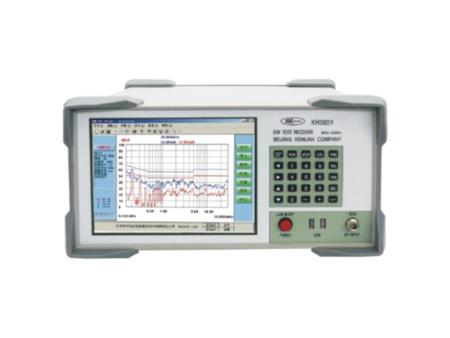EMI Receiver KH3939
Electromagnetic Interference Scanning System The KH3939 EMI Test Receiver is a fully automated test receiver and the primary tool for EMI testing. The frequency range is from 9kHz to 300MHz, which fully satisfies the power line disturbance power test. After the artificial power network is configured, the power terminal disturbance voltage test can be performed. The machine has fast test speed, strong maneuverability, stable performance and convenient test data processing. Etc. It is the first to use the USB interface for data transmission in the country, and supports external devices such as printers, mice, keyboards, etc. of the USB interface. The machine is equipped with a high-speed large-capacity hard disk.
The KH3939 EMI test receiver is a fully automated test receiver and the primary tool for EMI testing.
The frequency range is from 9kHz to 300MHz, which fully satisfies the power line disturbance power test. After the artificial power network is configured, the power terminal disturbance voltage test can be performed. The machine has fast test speed, strong maneuverability, stable performance and convenient test data processing. Etc.
It is the first to use the USB interface for data transmission in the country, and supports external devices such as printers, mice, keyboards, etc. of the USB interface. The machine is equipped with a high-speed large-capacity hard disk, which stores data of various external devices, and supports plug-and-play various external devices. Test Equipment. The software is developed by our company and uses windows as the carrier. Users who are familiar with windows can quickly get started. The machine can be independently tested without any additional control equipment to control the operation, which fundamentally solves the problem of interference sources. The measurement results can be input to the hard disk of the receiver or saved to a floppy disk or directly printed output via a floppy drive or saved using a USB storage device. Detailed measurement reports can be printed directly according to user needs without additional editing.
Features
1. Perform a rough scan and measure the two curves of the peak and the average; or measure the average or peak.
2. Perform automatic quasi-peak measurement on the frequency point exceeding the standard. It can also observe the dynamic change of the quasi-peak value of a single frequency point. The intuitive graphical energy bar displays the terminal test voltage value and has the maximum value retention function.
3. The limits of different standards can be set and modified arbitrarily, and the method is simple and the function is perfect.
4, according to different accessories to select the conductivity factor instrument automatically data processing data.
5, the instrument can be final test, each band to measure the quasi-peak and average of the maximum point; can also be artificially selected for quasi-peak and average final measurement.
6. The instrument can give a test report of the result. The report can be added to the tester's information. The report can be printed directly or the electronic version can be saved. The report can be output via the USB port. The report format can be transmitted on the network in a common format.
7. The software design is more user-friendly, and the upper and lower limits can be adjusted during the test to achieve the best display effect. You can also zoom in on any range to view test data more accurately. A wealth of help information to help users have a deeper understanding of the various functions of the device.
Product parameters
The error given by this instrument is the working error, that is, the error measured under the rated condition.
1. Measuring frequency range: 9kHz ~ 300MHz
2. Frequency resolution: (9kHz ~ 150kHz): 30Hz;
(150kHz to 30MHz): 1kHz
(30MHz ~ 300MHz): 10kHz
3. Frequency stability: 10 -6
4. Input impedance: 50W
5. Standing wave coefficient: 1.3 (RFATT > 10dB)
6. Test mode: average value, quasi-peak value, peak value
7. Terminal voltage measurement range: 0dB ~ 120dB (S / N = 6dB 1mV = 0dB)
8. Terminal voltage measurement error: (under standard operating conditions) ≤ ± 2dB
9. Field strength measurement range: Add the attenuation coefficient of the antenna over the range of the terminal voltage
10. Field strength measurement error: ≤ ± 4dB
11. IF attenuation: not less than 40dB
12. Mirror channel attenuation: not less than 35dB
13. Whole machine passband (-6dB): 200Hz, 9kHz, 120kHz
14. Overload factor: 30dB before detection
After detection, DC amplifier ≥ 12dB
15. Detector time constant:
(1) Average value: charge and discharge time constant is less than 1 ms
(2) Quasi-peak: charging time constant 1ms
Discharge time constant 160ms±10ms
16. Head mechanical time constant: 160ms ± 80ms
17. Pulse characteristics
(1) Absolute characteristics: for a pulse signal with a spectral density of 0.316 mV·S repetition frequency of 100 Hz,
The EMF tester shall not exceed ±1.5dB of the electromotive force reading of a sinusoidal signal with a 66dB rms value.
18. Stray interference suppression: no less than 40dB
19. Shielding effect: no less than 60dB
20. Parasitic signal: no more than 3 points, the level is less than 30dB.
21. Power supply: AC 220V, 50Hz, power consumption is no more than 70W
The instrument can still work normally when the AC voltage changes by ±10%.
22. Scanning mode: scan range, step size, level threshold can be set
23. Mode of operation: fully automatic, manual
24. Display mode: TFT color LCD display
25. Frequency standard display: level and frequency
26. Antenna Correction: Automatic
27. Output mode: 1. With USB interface, test data or test report can be copied through mobile hard disk or USB flash drive.
2, floppy disk storage,
3, print and output,
28. Software: equipped with data reading software
29. Interface: USB interface
30. Can be equipped with a mouse, keyboard and LCD
31. Power supply: 50Hz 220V
32. Dimensions of the instrument: 420mm × 430mm × 144mm
33. Host weight: about 14kg

